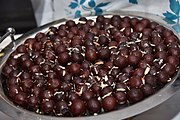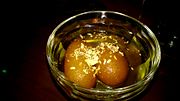 Gulab jamun topped with rose petals Gulab jamun topped with rose petals | |
| Alternative names | Gulab jaman, Lal mohan, Gulab jam, Gulap jam |
|---|---|
| Course | Dessert |
| Region or state | Indian subcontinent, Mauritius, Fiji, southern and eastern Africa, the Caribbean, the Malay Peninsula |
| Serving temperature | Hot, cold or at room temperature |
| Main ingredients | Khoa, saffron, maida |
| Variations | Pantua, kalo jam |
Gulab jamun (also spelled gulaab jamun; lit. 'Rose water berry' or 'Rose berry') is a sweet confectionary or dessert, originating in the Indian subcontinent, and a type of mithai popular in India, Pakistan, Nepal, the Maldives and Bangladesh, as well as Myanmar. It is also common in nations with substantial populations of people with South Asian heritage, such as Mauritius, Fiji, Gulf states, the Malay Peninsula, United Kingdom, United States, Canada, South Africa, and the Caribbean countries of Jamaica, Trinidad and Tobago, Guyana, and Suriname.
It is made mainly from milk solids, traditionally from khoya, which is milk reduced to the consistency of a soft dough. Modern recipes call for dried or powdered milk instead of khoya. It is often garnished with dried nuts, such as almonds and cashews, to enhance flavour.
Preparation
In the Indian subcontinent, milk and cheese solids are prepared by heating milk over a low flame until the water content has evaporated and only the milk solids, known as khoya, remain. The solids are kneaded with flour (maida), and small balls of this dough are deep-fried in oil or ghee (clarified butter) at a low temperature, then soaked in a light sugar syrup flavored with green cardamom and rose water, kewra or saffron. Hot gulab jamun is often served with vanilla ice cream, or kulfi.
Origins
According to culinary historian Michael Krondl, 12th century Manasollasa mentions a recipe for fried fritter balls made of chenna cheese and rice flour and was soaked in cardamom-scented syrup, but this recipe did not use rosewater (gulab) syrup. The 13th century Arab dessert luqmat al-qadi is similar in appearance to gulab jamun, although it is made of entirely different batter than gulab jamun but was soaked in rosewater-scented (gulab) syrup, the only Persian connection may be the common use of rosewater syrup. Gulab Jamun emerged in medieval India during the Mughal Empire, blending Persianate influence with local influences that eventually became gulab jamun. The word "gulab" is derived from the Persian words gul (flower) and āb (water), referring to the rose water-scented syrup, and "Jamun" or "jaman" is the Hindi word for Syzygium jambolanum, an Indian fruit with a similar size and shape, commonly known as black plum. Jamun is also defined as a fried delicacy in sugar syrup.
Special occasions
Gulab jamun is often eaten at festivals, birthdays or major celebrations such as marriages, the Muslim celebrations of Eid ul-Fitr and Eid al-Adha, and the Hindu festivals of Diwali and Ganesh Chaturthi. There are various types of gulab jamun.
-
 Gulab jamun in a glass
Gulab jamun in a glass
-
 Gulab jamun with almond pieces
Gulab jamun with almond pieces
-
 Gulab jamun often comes with chashni syrup
Gulab jamun often comes with chashni syrup
-
Served with saffron
-
With vark
-
 Two pieces of Gulab jamun
Two pieces of Gulab jamun
-
 Mini Gulab Jamun
Mini Gulab Jamun
Variants


India

Gulab jamun gets its brownish red colour because of the sugar content in the milk powder (khoya). In other types of gulab jamun, sugar is added in the batter, and after frying, the sugar caramelization gives it its dark, almost black colour, which is then called kala jamun or "black jamun". The sugar syrup may be replaced with (slightly) diluted maple syrup for a gulab jamun.
Homemade gulab jamun is usually made up of khoya, a pinch of all-purpose flour/refined wheat flour/ wheat flour (optional), baking powder and clarified butter (ghee); milk kneaded to form a dough, moulded into balls, deep fried and dropped into simmering sugar syrup.
In Bengali, Gulab Jamun is known as Kalo Jam or Pantua, which is similar to gulab jamun, and could be called a Bengali variant of that dish. Ledikeni, a variation of Pantua, is another variant of gulab jamun. It is said to have been invented by Bhim Chandra Nag on the occasion of a visit by Lady Canning, the wife of Charles Canning, the Governor-General of India during 1856–62.
Katangi, a town near Jabalpur is famous for "Jhurre Ka Rasgulla", which has been made there for the past 100 years. It is several times the size of normal gulab jamuns and is prepared in local desi ghee.
In Rajasthan, instead of soaking gulab jamun balls in sugar syrup, they are cooked in gravy made from spices, nuts and tomato to make popular Gulab Jamun ki Sabzi.
In Western Madhya Pradesh and Malwa, Mawa Bati is popular as local version of Gulab Jamun.
It is different from Gulab jamun by size, fillings and amount of sweetness, Mawa bati is usually not immersed in Sugar syrup and slightly larger than Gulab Jamun.
Bangladesh
In Bangladesh, Pantua is available almost everywhere throughout the country, which can be referred to a Bengali variation of Gulab jamun. Also there are two kinds of jamuns that are famous. They are Golap Jam (গোলাপ জাম) and Kalo Jam (কালো জাম).
Nepal
The sweet is known as Lal Mohan (लालमोहन) in Nepali language and is available at almost every sweet shop. The sale of the sweet usually increases significantly during festivals such as Tihar, Dashain, etc.
See also
- Bamiyeh
- Chak-Chak
- Chè xôi nước
- Doughnut holes
- Leche frita
- List of desserts
- Lokma
- Lyangcha
- Puff-puff
- Rasgulla
- Struffoli
- Tangyuan
References
- Marty Snortum, Lachu Moorjani (2005). Ajanta: regional feasts of India. Gibbs Smith. p. 17. ISBN 1-58685-777-0.
- shraddha.bht. "Gulab Jamun". Konkani Recipes. Retrieved 25 May 2010.
- Michael Krondl (2011). Sweet Invention: A History of Dessert. Chicago Review Press. p. 7-8. ISBN 978-1-55652-954-2.
In another recipe he gives directions for a syrup-soaked fritter many modern Indians would recognize. To make it, the cook is told to curdle warm milk by adding buttermilk, then strain it to remove the liquid. (Nowadays this fresh cheese would be called chhana.) The resulting curds are then mixed with a little rice flour, formed into balls, and fried in ghee. Finally, they are soaked in syrup.
- Michael Krondl (1 June 2014). The Donut: History, Recipes, and Lore from Boston to Berlin. Chicago Review Press. pp. 7–8. ISBN 978-1-61374-673-8.
To make it, you form balls out of a dough of fresh cheese curds mixed with rice flour, fry these in ghee, and then soak them in cardamom-scented syrup. I imagine the king feeding the morsels—tender, buttery, and dripping with the perfumed syrup—to his favorite as she lies resplendent on a silk-lined bed. Most of these fritters still exist and in more than one variation.
- Michael Krondl (2011). Sweet Invention: A History of Dessert. Chicago Review Press. p. 38. ISBN 978-1-55652-954-2.
A fitters of very similar appearance is made in the Middle East under the name Luqmat Al Qadi. It is conceivable that they both developed from an earlier Persian antecedent. Gulab comes from the Persian word for rosewater, while Jamun refers to a local fruit of roughly this size. The two batters are made entirely differently, though, so the only Persian connection may be the common use of rosewater syrup.
- Michael Krondl (2011). Sweet Invention: A History of Dessert. Chicago Review Press. p. 38. ISBN 978-1-55652-954-2.
The two batters are made entirely differently, though, so the only Persian connection may be the common use of rosewater syrup...Gulab comes from the Persian word for rosewater, while jamun refers to a local fruit of roughly this size."
- Elliott, Victoria Grace (30 November 2021). Yummy: A History of Desserts (A Graphic Novel). Random House Children's Books. p. 28. ISBN 978-0-593-12439-0.
- Achaya K. T. (1994). Indian Food Tradition A Historical Companion. Oxford University Press. ISBN 9780195628456. Retrieved 29 January 2019.
- Charmaine O'Brien (2003). Flavours of Delhi: A Food Lover's Guide. Penguin Books Limited. p. 145. ISBN 978-93-5118-237-5.
- Richardson, Tim H. (2002). Sweets: A History of Candy. Bloomsbury USA. p. 334. ISBN 1-58234-229-6.
- "यहां के रसगुल्लों के लिए थम जाते हैं वाहनों के पहिए". www.patrika.com. 10 January 2016. Retrieved 24 September 2019.
- उसमें प्राण जगाओ साथी- 3, मायाराम सुरजन, Deshbandhu, 2009-11-12, जबलपुर-दमोह के बीच कटंगी के रसगुल्ले, 1959
- "Folk music. Katangi ke rasgulla. AKASH sahu". 31 May 2016. Retrieved 24 September 2019 – via www.youtube.com.
- "Mawa Bati | District Raisen, Government of Madhya Pradesh | India". Retrieved 24 November 2023.
- sampurna. "सबैको प्यारो लालमोहन". Sampurna Weekly. Archived from the original on 5 December 2022. Retrieved 5 December 2022.
External links
| Main and side dishes |
| ||||||
|---|---|---|---|---|---|---|---|
| Snacks and sauces | |||||||
| Breads | |||||||
| Beverages | |||||||
| Sweetmeats | |||||||
| Bangladeshi diaspora | |||||||
| Balochi |  | ||||
|---|---|---|---|---|---|
| Kashmiri | |||||
| Muhajir |
| ||||
| Pashtun | |||||
| Punjabi |
| ||||
| Saraiki | |||||
| Sindhi | |||||
| Common dishes |
| ||||
| Pakistani diaspora | |||||
| Burmese cuisine | |
|---|---|
| Salads | |
| Rice dishes | |
| Noodle dishes | |
| Other dishes | |
| Snacks |
|
| Drinks and beverages | |
| Seasonings and ingredients | |
| Miscellaneous | |
| Doughnuts, fritters and other fried-dough foods | ||||||||
|---|---|---|---|---|---|---|---|---|
| Sweet |
| |||||||
| Savory |
| |||||||
| Companies | ||||||||
| Lists | ||||||||
| See also |
| |||||||
| Cheese dishes | |
|---|---|
| Dishes |
|
| Sandwiches |
|
- Indian desserts
- Uttar Pradeshi cuisine
- Bihari cuisine
- Sri Lankan cuisine
- Pakistani desserts
- Nepalese cuisine
- Punjabi cuisine
- Sindhi cuisine
- Pashtun cuisine
- Balochi cuisine
- Kashmiri cuisine
- Mauritian cuisine
- Bangladeshi desserts
- Bengali desserts
- Cheese desserts
- Fijian desserts
- Burmese desserts and snacks
- Deep fried foods
- Doughnuts
- Indian doughnuts
- Trinidad and Tobago cuisine
- Holiday foods
- Nut desserts
